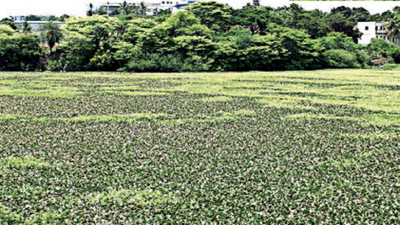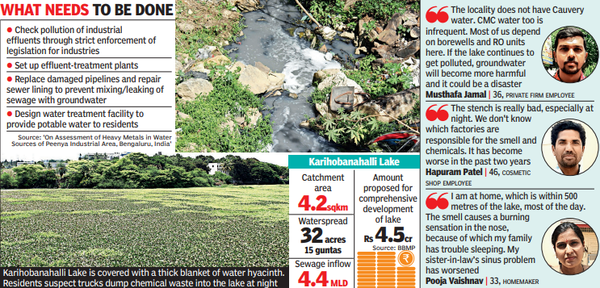- News
- City News
- bengaluru News
- It may not froth, but this lake in Peenya is choking too
Trending
It may not froth, but this lake in Peenya is choking too

Karihobanahalli Lake is covered with a thick blanket of water hyacinth. Residents suspect trucks dump chemical waste into the lake at night
BENGALURU: The plight of Karihobanahalli Lake in Peenya industrial area seems to be no better than the infamous Bellandur Lake, but the former doesn't receive as much attention, lament residents living near the waterbody.
Karihobanahalli Lake is shrouded in a thick blanket of water hyacinth. Slowly streaming into the hyacinth shroud is a streak of greywater. The stream has patches of foam but there is no sign of it anywhere else in the waterbody. With no fence around the lake, one can witness polythene bags scattered near it. A sewage treatment plant (STP) is in place, but locals have rarely seen it function.

The authorities had assured the residents of intervention, but there has been no progress. The dying lake's effects are being felt beyond the waterbody.
When water from one of the borewells in the neighbourhood was tested using a commercially available Total Dissolved Solids (TDS) tester, the reading was 1120 parts per million (ppm). Shashi Shekhar, department of civil engineering, East West Institute of Technology, who has ao-cuthored a study on presence of heavy metals in the soil samples of Peenya industrial area, told STOI the ideal upper limit of TDS, which indicates hardness of water and dissolved minerals, is 300-400 ppm.
Residents said it seemed like trucks dump chemical waste into the lake at night and the stench gets stronger. "Although we complained to local MLA ST Somashekar, who assured us of action before the elections, the issue still remains. Despite BBMP calling for suggestions on a detailed project report for comprehensive development and rehabilitation of the lake in 2022, there has been no action. The water colour changes with the industrial effluents that bleed into it. The groundwater too is affected, and we have started feeling an itch after using borewell water in the area," locals said. The lake was taken over by BBMP from BDA in 2020.
While the MLA did not respond to calls, BBMP chief engineer (lakes) Vijaykumar Haridas said the fund allocated for rejuvenation of lakes has been divided between three waterbodies and work will be executed based on the fund availability. Industrial sewage will be diverted, after which desilting and rejuvenation work will take place. When the department officials visited the site last week, there was a lot of sewage in the lake, he confirmed.
In their research paper - On Assessment of Heavy Metals in Water Sources of Peenya Industrial Area, Bengaluru, India - faculty members of various educational institutions in Karnataka said analyses of groundwater and surface water samples in Peenya industrial area have shown almost 90% are unfit for drinking.
-Shivika Kumar
& Keziah Mariam Suresh
Karihobanahalli Lake is shrouded in a thick blanket of water hyacinth. Slowly streaming into the hyacinth shroud is a streak of greywater. The stream has patches of foam but there is no sign of it anywhere else in the waterbody. With no fence around the lake, one can witness polythene bags scattered near it. A sewage treatment plant (STP) is in place, but locals have rarely seen it function.

The authorities had assured the residents of intervention, but there has been no progress. The dying lake's effects are being felt beyond the waterbody.
When water from one of the borewells in the neighbourhood was tested using a commercially available Total Dissolved Solids (TDS) tester, the reading was 1120 parts per million (ppm). Shashi Shekhar, department of civil engineering, East West Institute of Technology, who has ao-cuthored a study on presence of heavy metals in the soil samples of Peenya industrial area, told STOI the ideal upper limit of TDS, which indicates hardness of water and dissolved minerals, is 300-400 ppm.
Residents said it seemed like trucks dump chemical waste into the lake at night and the stench gets stronger. "Although we complained to local MLA ST Somashekar, who assured us of action before the elections, the issue still remains. Despite BBMP calling for suggestions on a detailed project report for comprehensive development and rehabilitation of the lake in 2022, there has been no action. The water colour changes with the industrial effluents that bleed into it. The groundwater too is affected, and we have started feeling an itch after using borewell water in the area," locals said. The lake was taken over by BBMP from BDA in 2020.
While the MLA did not respond to calls, BBMP chief engineer (lakes) Vijaykumar Haridas said the fund allocated for rejuvenation of lakes has been divided between three waterbodies and work will be executed based on the fund availability. Industrial sewage will be diverted, after which desilting and rejuvenation work will take place. When the department officials visited the site last week, there was a lot of sewage in the lake, he confirmed.
In their research paper - On Assessment of Heavy Metals in Water Sources of Peenya Industrial Area, Bengaluru, India - faculty members of various educational institutions in Karnataka said analyses of groundwater and surface water samples in Peenya industrial area have shown almost 90% are unfit for drinking.
-Shivika Kumar
& Keziah Mariam Suresh
Start a Conversation
FOLLOW US ON SOCIAL MEDIA
FacebookTwitterInstagramKOO APPYOUTUBE










